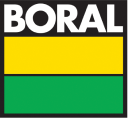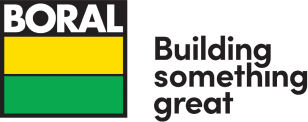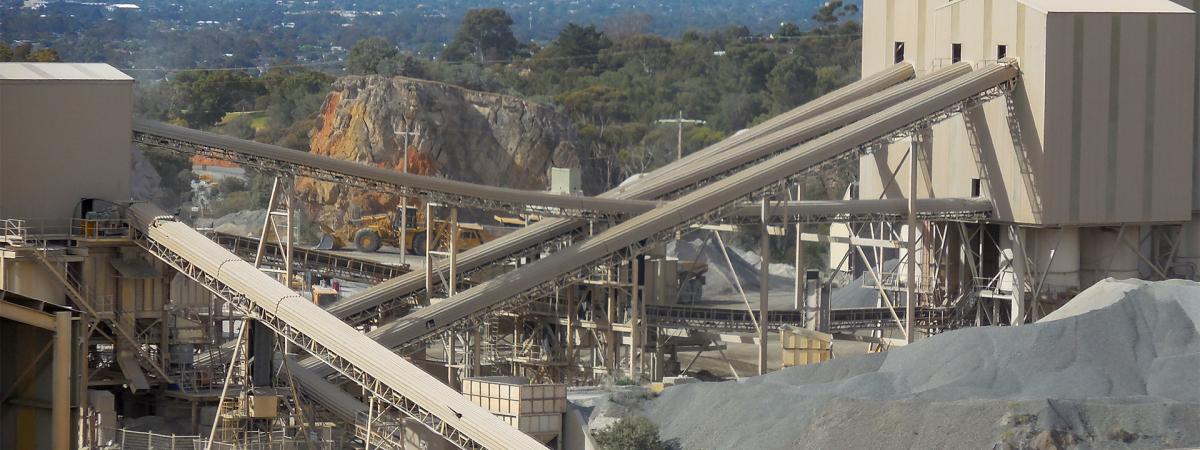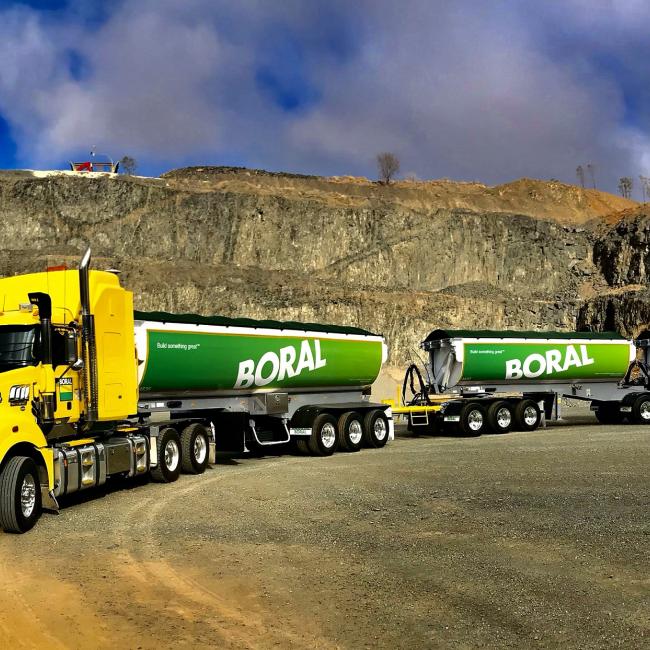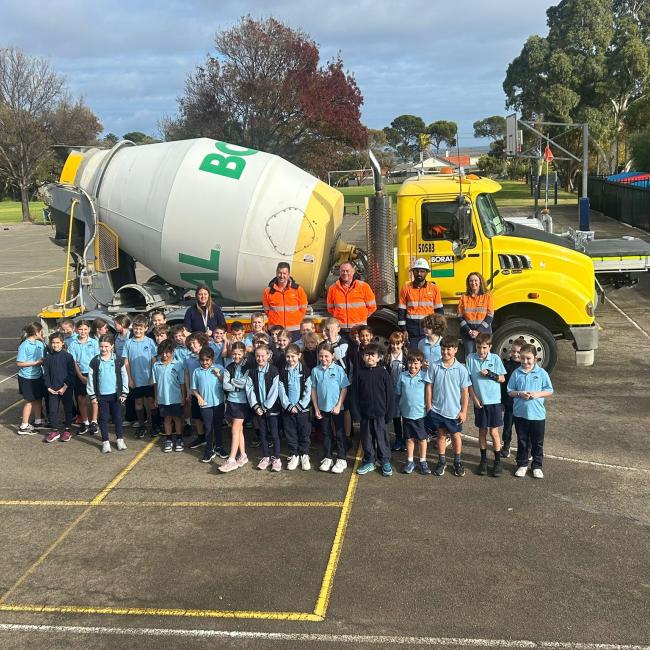The Boral Linwood Quarry, positioned within one of Adelaide and South Australia's most important sources of hard rock, has been providing aggregates for almost 130 years.
The Boral Linwood Quarry is located between Marino and Hallett Cove, not far from the shore of the Gulf of St Vincent, in Adelaide's southern suburbs. The Linwood site incorporates landholdings which are both owned by Boral, and leased from other landowners in return for royalties. A number of 'private mines' and small extractive mineral leases allow quarrying on these lands.
The quarry is bordered by the City of Marion Golf Club to the north east, itself having been formed on the original South Australian Portland Cement Company workings.
Vacant 'hills face zone' land exists to the east and southeast of the quarry as bounded by Ocean Boulevard and Perry Barr Road.
Today the Boral Linwood Quarry employs 30 full time staff and provides work for up to 80 contractors and transport workers. Many employees reside in the City of Marion within which the quarry is located.
In addition to the quarry and its processing plant, the site also hosts Boral Marino Concrete, part of Boral's network of concrete plants servicing the city.
Quarrying first began in 1882 to provide raw material (limestone) to the nearby Brighton Cement Works. By 1892, this operation had become The South Australian Portland Cement Company Limited.
In 1956, Quarry Industries Ltd took over operations at Linwood. This company was in turn purchased by Boral, with Linwood becoming part of the portfolio in 1994.
During Boral's stewardship, the focus for the operation has been the production of high quality road-base aggregates. The quarry has also been recognised as a model of best practice for the extractive industry in South Australia, having achieved several awards for its operations. During 2015, the quarry was identified as a 'strategic mineral resource' through the Resource Management and Planning (RAMP) report prepared for the South Australian Government. Boral Marino Concrete is one of five concrete batching plants operated by the company across Adelaide. It is sited within the Boral Linwood Quarry which supplies the plant with aggregates for production.
The plant produces pre-mixed concrete for commercial and residential projects throughout southern Adelaide and the city centre. The concrete is transported via Boral and contractor-owned 'agitators' (trucks).
Presently the plant employs three staff and two transport drivers.
Positive relationships with the community are an important part of conducting our business activities.
On this page you will find information about initiatives involving our neighbours and other local stakeholders, as well as updates on what's happening at our sites.
We are continuously improving processes at our site and Boral welcomes feedback from the community regarding our operations.
If you would like to contact us at any time, please email community@boral.com.au.
Information about our management of the potential effects of the Boral Linwood Quarry and Boral Marino Concrete on the environment are as follows:
Dust management
Ensuring the proper management of dust emissions from quarry sites is an industry-wide challenge. The Boral Linwood Quarry has implemented a program of initiatives across many years as part of addressing this challenge.
The management of dust emissions is one of the main environmental challenges facing quarry operators. Through its experience with the issue, the Boral Linwood Quarry has evolved into a model of best practice in SA for dust mitigation practices. The generation of dust at Linwood is greatly influenced by the coastal location of the quarry. It experiences predominantly off-shore, south-westerly winds through most of the year.
Adelaide is also the driest Australian capital city with unreliable, light and infrequent rain through summer. The dry and windy conditions this creates exacerbates any 'nuisance' dust factors present in the background. 'Fugitive dust' can be initiated by operational activities and a mixture of sources. Traffic using internal haul roads, crushing plant, and stockpile areas are the most significant contributors to dust emissions.
To account for these factors, the quarry has developed an active system for minimising the risk of dust emissions. This involves:
- Monitoring: Dust monitoring 'stations' have been established around the quarrying operations. These include five static deposition monitors, five directional monitors, three weather stations, and three state-of-the-art dichotomous samplers (TEOM's) which measure particulate matter 'PM10', 'PM2.5' in the atmosphere. The TEOM system provides site personnel with real-time data and is used to manage the timing of operational activities. The TEOM system is also utilised for regulatory reporting purposes. Public access to details of the 24-hour average PM10 readings at each of the TEOM's is available here.
One of our dust monitors is currently offsite being repaired, we will have it operating again as soon as it returns to site.
- Stockpile water spray system - An automatically activated water spray system was installed during 2014 for 'priority' stockpiles. The 24-hours-per-day system uses the most advanced technology currently available to operate.
- Water cart - During 2011, a new 'water cart' was purchased for the quarry. The 35000 litre vehicle is used to keep roads and hard surfaces at the site wet to decrease the chances of fugitive dust.
- Wheel wash - The site's wheel wash, through which all vehicles exiting the quarry must be driven, was upgraded during 2010 to include three stages, ensuring a better wash.
Enclosure of plant and conveyors - The primary crusher raw material feed hopper is roofed, enclosed on three sides, and has directional fine water sprays to minimise dust generation during tipping operations.
Conveyers are covered and product transfer points are fitted with fine water sprays. The final crushing and screening sections of the plant contain a dry dust collection system ('bag house') ducted to all crushers, screens, bins and conveyor transfer points.
- Street sweeping - Depending upon the frequency of sales and weather conditions, a street sweeper is regularly used at the quarry to clean the roads.
Rehabilitation and screening of the quarry
Extensive tree planting and screening mounds have been established around the quarry boundary over time to improve visual amenity.
These areas are maintained as part of an overall site management program. A management strategy has also been implemented which has seen:
the formation of a western screening mound and landscaping to match the adjacent completed areas;
- visual upper 'terminal' faces on the east side of the quarry being laid back to a gentle angle, backfilled with overburden and topsoil, grassed and established with small stands of trees and shrubs;
- the upper faces on the west and east sides of the quarry being laid back as quarrying has progressed southward. This has been done to create landforms which assimilates with the adjacent landscape; and
- the main overburden dump, located southwest of the quarry, continued filling across an east-west gully to a point of equal elevation towards the southern boundary. The final landform will be shaped and graded into the adjacent natural contours, grassed and planted with trees and shrubs.
Traffic Management
All trucks leaving site must leave via the 'wheel wash' at the exit. Waste water is captured and pumped into the site water recycling system for re-use in the truck wash and for dust suppression.
Waste Products
The Boral Marino Concrete plant contains 'washout' pits, used to collect waste concrete washed out of the bowls of concrete trucks.
Waste oil is placed into a single storage facility that is regularly emptied by a licensed contractor, and waste tracking forms are retained on-site.
Scrap steel is stockpiled and occasionally sold to waste metal merchants. Used tyres are sold or returned to the supplier.
Water Recycling
An on-site water recycling network has been established to serve the needs of the concrete plant, the quarry's 'pug mill', and to access road stormwater.
The eco-friendly design allows the site to capture, filter and re-use stormwater by:
- use of a filtration system for the truckwash, enabling clean water to be used for vehicle cleaning;
- diverting stormwater to designated storage areas to reduce road maintenance and safety issues from mud and water build up around the plant; and
- reducing mains water usage by 75 percent through filtering and re-using stormwater and waste water in the concrete and pugmill plants for production and wash down.
Here, you will find information about the approvals and conditions to which the Boral Linwood Quarry operates.
You can find details on any current planning applications and major projects for both operations below:
Boral Linwood Quarry entrance road relocation project (Jan 2021)
Work on Boral’s Linwood Quarry entrance road relocation project commenced on Friday 29 January when the Premier of South Australia, the Honourable Steven Marshall and the Minister for Environment and Water, the Honourable David Speirs officially ‘turned the sod’ onsite. Read more.
Reaching east - Linwood's future (Feb 2018)
Throughout 2017 and continuing into 2018, Boral continued to work to better inform local residents and stakeholders about the quarry and the direction it will take during the next decade. Of the various issues raised, the most critical is the commencement of planning to transition the site's operations from their current southward focus towards available rock resource to the east.We expect these plans to be finalised by the end of 2018. You can read more about our project to 'reach east' below.
The east - a new beginning for the Boral Linwood Quarry
As the resources in the southern part of Boral's land have been removed during recent years, planning was commenced for the next stage of the Linwood Quarry's life.
With no opportunities existing in the north and west, the development of the quarry into land on the eastern side of the existing pit became the primary focus. Boral accordingly worked over several years to secure ownership of, or lease arrangements for, this land ahead of the necessary planning approval processes.These arrangements are now largely finalised, enabling Boral to proceed with the relevant planning requirements. It is estimated there is up to 100 years' worth of resources within the potential eastern footprint. Much of this land is covered by an existing 'private mine', however, there is a significant part which has not been included in the quarry's lease before.
Gaining approval to quarry in the east
There is a detailed process which Boral will need to follow before any extractive activity can take place in the eastern portion:
- A full risk assessment must be conducted.
- Plans and an associated proposal document must be prepared.
- A mineral claim must be pegged and registered for the part of the land not covered by the private mines.
- A mining proposal must then be submitted.
- An application for an Extractive Mineral Lease (EML) can then be made.
- Once the EML is obtained, a Program for Environmental Protection and Rehabilitation (PEPR) must be developed.
Both the EML and the PEPR must be approved before any quarrying is able to take place. The environmental outputs which are common with quarries, such as dust emissions, blast vibrations and noise generation, must be identified at the 'mining proposal' stage. The proposal has to be able to address each of these issues by including suitable outcomes to be achieved while quarrying. With the full support of the community, Boral expects to be able to achieve approval for quarrying the eastern lands by 2019. You can view the concept plan for the pit design here. Please note that this is a concept plan only, and is not finalised nor approved by the regulatory authorities.
We have recently received approval from the Department of the Premier and Cabinet for our Exploration Program for Environment Protection and Rehabilitation (EPEPR), in January 2018. This EPEPR outlines how we will explore the lands to the east to understand its geological structure. Our consultant will request to do this via the drilling of ‘exploration’ and ‘seed’ holes. Understanding what was experienced late 2016, this process will be undertaken with extra guidance and caution by our team. We will consult with our neighbours, and give adequate notice of when any test blasts are due to occur. These activities can only occur with DPC approval of the EPEPR. As this application was successful, both the exploration and seed hole drilling occurred February 14, 2018. You can view the drill hole plan here.
Read our Community Update for more information
Accessing a new direction (Feb 2018)
Another issue which has been of interest to the local community is a proposal to relocate the quarry's main access road.
The proposal has arisen as a result of lengthy negotiations between Boral and the owners of a parcel of land to the north of the quarry, known locally as 'Cement Hill'.
The road - moving our access away from Marino and Seacliff
Most local residents are aware that access to the Boral Linwood Quarry is via Clubhouse Road, off Ocean Boulevard in Seacliff.
Adjoining our access road is a site known variously as the 'Lorenzin' land or 'Cement Hill'. This land has been unused for many years with the old buildings upon it having fallen into disrepair. The owners of the site, Adelaide development firm Gasparin, have held a long-standing desire to see this land developed into a housing estate.
Unfortunately, while Boral would like to see the site being put back into use, establishing housing would introduce a conflict with our right to conduct our business.
The conflict arises from the potential amenity issues new residents would experience as a result of living next to the quarry traffic and the operations. There would also be an increased safety risk to consider.
Through various discussions, the idea of moving the quarry's access from its present location to a new one further to the south arose. As of February 2018, the process to relocate the Linwood Quarry access road from Clubhouse Road is well underway, with the Majors Road intersection selected as the preferred option. Consultants have been engaged to deliver a Department of Planning Transport and Infrastructure (DPTI) approved design for the haul road and the Majors Road intersection. An initial ‘in principle’ design has been tested and adjusted and is now with DPTI for further approvals. You can view the concept design for the road here. Please note that this design is a concept only, and not a final approved design. Time frames are subject to regulatory approvals; however, the intention is to have works completed by the end of 2018. We will continue to keep you updated on the progress of this project.
Mining Tenements - SA Mining Act 1971
The Boral Linwood Quarry site occupies just over 208 hectares of land. Around 36 percent of this is owned by Boral, with the remainder leased for quarrying from other landowners. The present quarry pit runs diagonally from the north-east to the south-west within the landholdings. Under the Act, quarrying is permitted via three 'private mines' (PM 3, 4 and 22) and three extractive mineral licences (5730, 5731 and 5732). Boral also has an active mineral claim (3314) and a Miscellaneous Purposes Lease (T02396) over other parts of the landholding. Extractive activities at the quarry are managed to a Mine Operations Plan as approved by the State Government.
During 2016, Boral applied for a minor amendment to the MOP in order to include the additional resource in the southern part of the existing quarry pit. The variation, which was supported by the required risk assessment, was approved by the SA Department of State Development in December. You can view the approved risk assessment documentation here. Works to prepare the amended area for quarrying began during March 2017 including pegging of a new extraction line and erection of a new fenceline.
Neighbouring residents were notified of the amendment works via letter.
Boral Marino Concrete - approvals
The Marino Concrete plant is operated on 'existing use' rights given that it is sited within one of the 'Private Mines' and is considered an 'ancillary' use to the quarry.
General planning context of the quarry precinct
The quarry lies predominantly within the 'Hills Face Zone' and 'Extractive Industry Zone' defined in the City of Marion Development Plan. The northwestern part of the site is bounded by established residential development (Marino), with undeveloped residential and hills face zone land adjoining the remainder of the western boundary.
